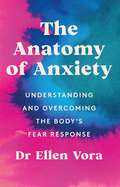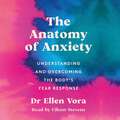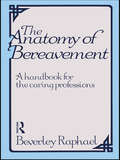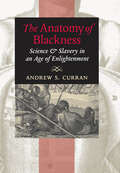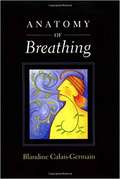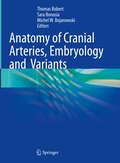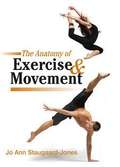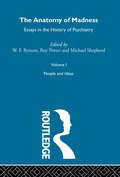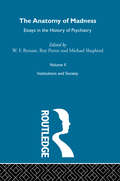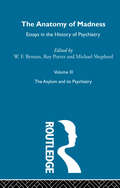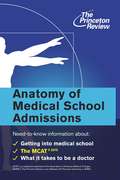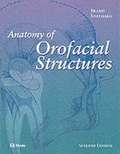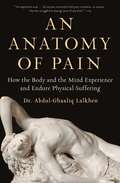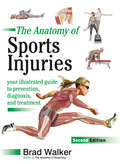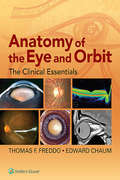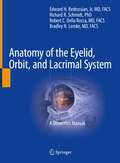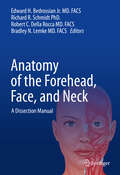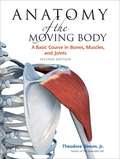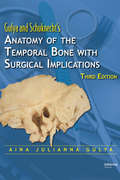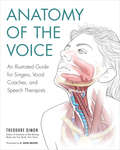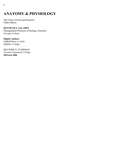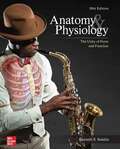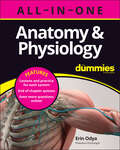- Table View
- List View
The Anatomy of Anxiety: Understanding and Overcoming the Body's Fear Response
by Dr Ellen Vora'A redeeming way to look at the condition, as not merely a burden but ultimately a blessing ... unexpectedly moving ... validating and hopeful' GuardianAnxiety. It's all in your head, right? Wrong.Psychiatrist Dr Ellen Vora challenges the conventional view of anxiety as a mental disorder, suggesting instead that much of what we call anxiety begins in the body. Rather than our troubled thoughts creating physical symptoms, she argues that many types of anxiety are the result of states of imbalance in our bodies, whether blood sugar crashes, caffeine highs or sleep deprivation.Her clinical observation shows this type of anxiety is far more preventable than we may realise, responding almost immediately to straightforward adjustments to diet and lifestyle.Backed by the latest scientific research and Dr Vora's own clinical work, The Anatomy of Anxiety offers a fresh, much needed look at mental health, offering actionable strategies for managing our moods.She further argues that other forms of anxiety, when listened to and honoured instead of suppressed, can be seen as a course correction to help nudge us back to a more balanced life.In her groundbreaking book, Dr Vora walks beside us through a healing process to reframe our relationship with anxiety, creating a more joyful and fulfilled life.
The Anatomy of Anxiety: Understanding and Overcoming the Body's Fear Response
by Dr Ellen Vora'A redeeming way to look at the condition, as not merely a burden but ultimately a blessing ... unexpectedly moving ... validating and hopeful' Guardian'An incredible paradigm shift in how we view anxiety' Dr Nicole LePera, author of international bestseller How to Do the WorkAnxiety. It's all in your head, right? Wrong.Psychiatrist Dr Ellen Vora challenges the conventional view of anxiety as a mental disorder, suggesting instead that much of what we call anxiety begins in the body. Rather than our troubled thoughts creating physical symptoms, she argues that many types of anxiety are the result of states of imbalance in our bodies, whether blood sugar crashes, caffeine highs or sleep deprivation.Her clinical observation shows this type of anxiety is far more preventable than we may realise, responding almost immediately to straightforward adjustments to diet and lifestyle.Backed by the latest scientific research and Dr Vora's own clinical work, The Anatomy of Anxiety offers a fresh, much needed look at mental health, offering actionable strategies for managing our moods.She further argues that other forms of anxiety, when listened to and honoured instead of suppressed, can be seen as a course correction to help nudge us back to a more balanced life.In her groundbreaking book, Dr Vora walks beside us through a healing process to reframe our relationship with anxiety, creating a more joyful and fulfilled life.
The Anatomy of Bereavement: A Handbook for the Caring Professions (The\caring Professions Ser.)
by Beverley RaphaelFirst published in 1985. Routledge is an imprint of Taylor & Francis, an informa company.
The Anatomy of Blackness: Science and Slavery in an Age of Enlightenment
by Andrew S. Curran2012 Outstanding Academic Title, Choice MagazineThis volume examines the Enlightenment-era textualization of the Black African in European thought. Andrew S. Curran rewrites the history of blackness by replicating the practices of eighteenth-century readers. Surveying French and European travelogues, natural histories, works of anatomy, pro- and anti-slavery tracts, philosophical treatises, and literary texts, Curran shows how naturalists and philosophes drew from travel literature to discuss the perceived problem of human blackness within the nascent human sciences, describes how a number of now-forgotten anatomists revolutionized the era’s understanding of black Africans, and charts the shift of the slavery debate from the moral, mercantile, and theological realms toward that of the "black body" itself. In tracing this evolution, he shows how blackness changed from a mere descriptor in earlier periods into a thing to be measured, dissected, handled, and often brutalized. Penetrating and comprehensive, The Anatomy of Blackness shows that, far from being a monolithic idea, eighteenth-century Africanist discourse emerged out of a vigorous, varied dialogue that involved missionaries, slavers, colonists, naturalists, anatomists, philosophers, and Africans themselves.
Anatomy Of Breathing
by Blandine Calais-GermainMy hope is that [this book] will contribute to a more enlightened practice of breathing. I also hope that you, the reader, will have a better understanding of how breathing changes spontaneously from moment to moment. My other wish is that you will discover how to consciously choose a specific breathing technique for certain purposes or circumstances. -- Author s Preface Everyone breathes, yet few of us understand how to consciously control breathing to improve our well-being and the quality of many daily activities. Anatomy of Breathing is a clear and helpful guide to both the theory and practice of breathing in its many variations. Hundreds of expert drawings along with easy-to-understand text help you explore just how breathing works. Once you re acquainted with the principal organs, structures, and forces that affect breathing, you will learn how to control them to enhance the quality and variety of breathing in your own life. Along the way, you will also correct many common misconceptions about breathing. Anatomy of Breathing is filled with helpful practice pages. Here you will learn simple exercises to prepare your body for the benefits of different types of breathing. You will then be shown, step by step, how to practice some of the most common and useful breathing techniques on your own. Anatomy of Breathing is a unique and wonderful resource for anyone who wishes to understand the science and art of breathing, and how to make their own breathing better and more life-enhancing.
Anatomy of Cranial Arteries, Embryology and Variants
by Thomas Robert Sara Bonasia Michel W. BojanowskiThis book on the anatomy of central nervous system arteries concentrates on all anatomical variations of the central nervous system and it describes the embryological processes that hide behind the possible adult variants.The first section of the work is a reminder of general concepts of embryology. After that, each section corresponds to arteries of an anatomical location: intradural, dural, skull base and cranio-cervical junction. Each chapter is dedicated to a single artery to facilitate the reader’s search for information. In addition, modern and detailed illustrations of the embryological steps and adult variants are included. There are two types of illustrations: artist’s drawing, usually to explain the vascular embryology, and angiographic images. The central point of the book lies in the space devoted to the embryological development of each artery and the processes that can lead to the development of different variants in the adult. The audience of this book is aimed at neurosurgeons and neuroradiologists, specialists in the neurovascular area, but it will also help residents in neurosurgery, neuroradiology and neurology in their daily practice.
The Anatomy of Deception
by Lawrence GoldstoneA mesmerizing forensic thriller that thrusts the reader into the operating rooms, drawing rooms, and back alleys of 1889 Philadelphia, as a young doctor grapples with the principles of scientific process to track a daring killerIn the morgue of a Philadelphia hospital, a group of physicians open a coffin and uncover the corpse of a beautiful young woman. What they see takes their breath away. Within days, one of them strongly suspects that he knows the woman’s identity…and the horrifying events that led to her death. But in this richly atmospheric novel–an ingenious blend of history, suspense and early forensic science–the most compelling chapter is yet to come, as young Ephraim Carroll is plunged into a maze of murder, secrets and unimaginable crimes....Dr. Ephraim Carroll came to Philadelphia to study with a leading professor, the brilliant William Osler, believing that he would gain the power to save countless lives. As America hurtles toward a new century, medicine is changing rapidly, in part due to the legalization of autopsy–a crime only a few years before. But Carroll and his mentor are at odds over what they glimpsed that morning in the hospital’s Dead House. And when a second mysterious death is determined to have been a ruthless murder, Carroll can feel the darkness gathering around him–and he ignites an investigation of his own.Soon he is moving between the realm of elite medicine, Philadelphia high society, and a teeming badlands of criminality and sexual depravity along the city’s fetid waterfront. With a wealthy, seductive woman clouding his vision, the controversial artist Thomas Eakins sowing scandal, and the secrets of the nation’s powerful surgeons unraveling around him, Carroll is forced to confront an agonizing moral choice–between exposing a killer, undoing a wrong, and, quite possibly, protecting the future of medicine itself….From the Hardcover edition.
The Anatomy of Exercise And Movement: For the Study of Dance, Pilates, Sport and Yoga
by Jo Staugaard-JonesThis book serves as a bridge between biomechanics and the practice of sport, Pilates, yoga, and dance, providing the reader with a complete understanding of how the body functions while exercising.
Anatomy Of Madness Vol 1: People And Ideas (Routledge Library Editions Ser.)
by W F Bynum Michael Shepherd Roy PorterFirst Published in 2004. Routledge is an imprint of Taylor & Francis, an informa company.
Anatomy Of Madness Vol 2: People And Ideas (Routledge Library Editions Ser.)
by W F Bynum Michael Shepherd Roy PorterFirst Published in 2004. Routledge is an imprint of Taylor & Francis, an informa company.
Anatomy Of Madness Vol 3: People And Ideas (Routledge Library Editions Ser.)
by W F Bynum Michael Shepherd Roy PorterFirst Published in 2004. Routledge is an imprint of Taylor & Francis, an informa company.
Anatomy of Medical School Admissions: Need-to-Know Information about Getting into Med School, the MCAT, and What it Takes to Be a Doctor (Graduate School Admissions Guides)
by Princeton ReviewThe Princeton Review Knows Med School. Thinking about a career in medicine? This is the book you need to ensure you're prepared in every way: Learn about medical school admissions, career options, how to prepare yourself as an undergrad, and, of course, about the major changes coming to the MCAT in 2015. The health system of tomorrow will require a different kind of physician. With over 30 years of experience and a proven track record helping millions of students achieve their goals, The Princeton Review is the only company with the expertise and resources to guide you through each step of your journey. We're not just about test prep: we're about prepping for your life. Inside this eBook, you'll find guidance and advice on topics like:* Do You Have What it Takes? (Thinking Like a Medical Student)* Is a Career in Medicine Right For You? (What They Don't Tell You at Career Day)* Everything You Need to Know about Med School Admissions* Researching Medical Schools, or ... Making the List* Q&A With Admissions Officers* The Inside Scoop on Applications, Personal Statements, Financial Aid, and More ...* How to Rock the Interview* The MCAT: Now and 2015* Preparing for and Taking the MCAT* Sample Personal Statements
Anatomy of Orofacial Structures (Seventh Edition)
by Richard W. Brand Donald E. IsselhardThis comprehensive edition on orofacial structures provides a complete introduction with dedicated sections on dental anatomy,oral histology and embryology, head and neck anatomy.
An Anatomy of Pain: How the Body and the Mind Experience and Endure Physical Suffering
by Dr. Abdul-Ghaaliq LalkhenAn illuminating, authoritative, and in-depth examination of the fascinating science behind pain and the complexities of its treatment—from one of the internationally leading doctors in pain management.Pain is a universal human experience, but we understand very little about the mechanics behind it. We hurt ourselves, we feel pain, we seek help from a professional or learn to avoid certain behaviors that cause pain. But the story of what goes on in our body is far from simple. Even medical practitioners themselves often fail to grasp the complexities between our minds and bodies and how they interact when dealing with pain stimulus. Throughout history we&’ve tried to prevent and mediate the effects of pain—which has only resulted in a highly medicated population and a booming opiates industry. Written by a medical expert trained as an anesthesiologist, An Anatomy of Pain is the first book to clearly explain the current issues and complexities surrounding the treatment of pain and how society deals with those in pain, as well as how our bodies relate to pain. Common conception still equates pain with tissue damage but that is only a very small part of the story—the organ which produces pain is the brain. Case studies show that a woman who has undergone a c-section reports dramatically less pain than a patient who has had kidney stones removed in a similarly invasive operation. The soldier who drags himself or herself to safety after being shot deals with pain in a remarkably different way from someone suffering a similar injury on a street. The truth is that pain is a complex mix of nerve endings, psychological state, social preconceptions, and situational awareness. Filled with case studies and medical history, this enlightening book offers a crash course in all aspects of pain, from chronic to acute, and walks us through the current landscape of pain treatments—from medication (including opioids) to electrical nerve stimulation. Whether it&’s a mild ache or severe discomfort, we all encounter pain in our lives and this important and illuminating book allows us to master the art of caring and coping with an experience that for so many can become all-consuming.
The Anatomy of Sports Injuries, Second Edition: Your Illustrated Guide to Prevention, Diagnosis, and Treatment
by Brad WalkerFor anyone who plays sports and is looking to facilitate recovery or prevent injuriesEveryone who plays sports experiences injuries. Many people never fully recover because they're not aware of what they can do to facilitate recovery. But there's no need to simply resign yourself to "living with" a sports injury. In The Anatomy of Sports Injuries, author Brad Walker brings years of expertise--he works with elite-level and world-champion athletes, and lectures on injury prevention--to this how-to guide. The book takes a fundamental approach, bringing you inside the body to show exactly what is happening when a sports injury occurs. At the heart of The Anatomy of Sports Injuries are 350 images. This second edition includes updated illustrations and more anatomical information and is for every sports player or fitness enthusiast who has been injured and would like to know what the injury involves, how to rehabilitate the area, and how to prevent complications or injury in the future.
Anatomy of Strength Training
by Pat ManocchiaWorking out can be fun and rewarding. But if you're not doing it correctly, it can seem pointless, and even painful. Knowing the best way to build muscle-and knowing why it's the best way-can mean the difference between a lifelong devotion to exercise and a fabulously fit body, or giving up in frustration.Health and fitness expert Pat Manocchia gives readers the tools they need to embark on a journey of fitness and health, from basic movements to information on how to build a complete exercise plan. With step-by-step instructions and easy-to-follow illustrations of starting positions and movement paths, it's like having your very own personal trainer.Learn what to do and what not to do. For example, hands should be shoulder-width apart during a chin-up, and you should never, ever swing the body during that move. Keep a slight arch in the back while performing a dead lift, and do so by keeping the head up. Find out how to get results by following these and other exercises.Anatomy of Strength Training brings a new dimension to workouts, helping readers target every problem area-and helping them stay on the path to health and fitness.
Anatomy of the Eye and Orbit: The Clinical Essentials
by Thomas F. Freddo Edward ChaumMaster the Clinical Essentials of ocular and orbital anatomy for clinical practice! The eye is an organ of great complexity. Anatomy of the Eye and Orbit: The Clinical Essentials achieves the impressive task of presenting all the ocular anatomy that ophthalmology residents, optometry residents, and optometry students need to know – in a single accessible, high-yield volume. It emphasizes the aspects of eye and orbit anatomy that are most relevant to clinicians in training, providing the practical, real-world foundation necessary for practice.
Anatomy of the Eyelid, Orbit, and Lacrimal System: A Dissection Manual
by Edward H. Bedrossian Richard R. Schmidt Robert C. Della Rocca Bradley N. LemkeThis book is a dissection manual and atlas on the anatomy of the eyelid, orbit, and lacrimal system; it functions as a succinct yet comprehensive resource. Opening chapters provide an introduction to the topic and outline instruments needed for the dissections. Subsequent chapters then describe the dissection of the eyelid in various layered approaches. Then, further discussions demonstrate the neuroanatomy of the cranial fossae, the cavernous sinus, and the dissection of deep orbital structures from an anterior, superior and lateral approach. Closing chapters then examine the nasolacrimal system and nasal cavities Anatomy of the Eyelid, Orbit, and Lacrimal System is an expertly written invaluable resource for the surgeon seeking to enhance their knowledge and surgical skills.
Anatomy of the Forehead, Face, and Neck: A Dissection Manual
by Richard R. Schmidt Robert C. Della Rocca Bradley N. Lemke Edward H. Bedrossian Jr.Like its companion volume, Anatomy of the Eyelid, Orbit, and Lacrimal System: A Dissection Manual, this unique dissection manual provides a detailed step-by-step approach to the dissection of the forehead, face, and neck, in a structural, layered approach. This dissection manual follows an atlas format, with color photographs from past professional lectures and classroom courses, as well as line drawings, enhancing descriptions. Clinical correlations are also interjected throughout to highlight the importance of individual anatomic structures. Chapters describe the preparation and storage of specimens and the dissection of the forehead and eyebrows, the midface, nose, ear, and lower face, and the neck. Anatomy of the Forehead, Face, and Neck: A Dissection Manual is an expertly written, invaluable resource for surgeons seeking to enhance their knowledge and surgical skills.
Anatomy of the Moving Body, Second Edition: A Basic Course in Bones, Muscles, and Joints
by Theodore Dimon John QualterLearning anatomy requires more than pictures and labels; it requires a way "into" the subject, a means of making sense of what is being shown. Anatomy of the Moving Body addresses that need with a simple yet complete study of the body's complex system of bones, muscles, and joints and how they function. Beautifully illustrated with more than 100 3D images, the book contains 31 lectures that guide readers through this challenging interior landscape. Each part of the body is explained in brief, manageable sections, with components described singly or in small groups. The author doesn't just name the muscles and bones but explains the terminology in lay language. Topics include the etymology of anatomical terms; origins and attachments of muscles and their related actions; discussion of major functional systems such as the pelvis, ankle, shoulder girdle, and hand; major landmarks and human topography; and structures relating to breathing and vocalization. This second edition features all-new illustrations that use a 3D digital model of the human anatomical form. The book's thoroughness, visual interest, and clear style make it ideal for students and teachers of the Alexander and Feldenkrais techniques as well as for practitioners of yoga, Pilates, martial arts, and dance.
Anatomy of the Temporal Bone with Surgical Implications
by Aina Julianna GulyaDetailed knowledge of the complex microanatomy of the temporal bone is essential for surgeons executing invasive therapeutic procedures. Based on the human temporal bone collection at the Massachusetts Eye and Ear Infirmary, this lavishly illustrated Third Edition includes a DVD offering 159 full-color photomicrographs and side-by-side 3-D stereo i
Anatomy of the Voice: An Illustrated Guide for Singers, Vocal Coaches, and Speech Therapists
by Theodore Dimon G. David BrownThe first comprehensive, fully-illustrated approach to the voice that explains the anatomy and mechanics in detailed yet down-to-earth terms, for voice users and professionals of all kindsThis book is the first to explain, in clear and concise language, the anatomy and mechanics of the mysterious and complex bodily system we call the voice. Beautifully illustrated with more than 100 detailed images, Anatomy of the Voice guides voice teachers and students, vocal coaches, professional singers and actors, and anyone interested in the voice through the complex landscape of breathing, larynx, throat, face, and jaw. Theodore Dimon, an internationally recognized authority on the subject, as well as an expert in the Alexander Technique, makes unfamiliar terrain accessible and digestible by describing each vocal system in short, manageable sections and explaining complex terminology. The topics he covers include ribs, diaphragm, and muscles of breathing; the intrinsic musculature of the larynx, its structure and action; the suspensory muscles of the throat; the face and jaw; the tongue and palate; and the evolution and function of the larynx.
Anatomy & Physiology: The Unity of Form and Function
by Kenneth SaladinAnatomy and Physiology: The Unity of Form and Function tells a story comprised of many layers, including core science, clinical applications, the history of medicine, and evolution of the human body. Saladin combines this humanistic perspective on anatomy and physiology with vibrant photos and art to convey the beauty and excitement of the subject. To help students manage the tremendous amount of information in this introductory course, the narrative is broken into short segments, each framed by expected learning outcomes and self-testing review questions.
Anatomy & Physiology: The Unity of Form and Function
by Kenneth S. SaladinAnatomy & Physiology: The Unity of Form and Function weaves a narrative that is comprised of many layers, encompassing fundamental science, clinical applications, the evolution of the human body, and the history of medicine. Saladin integrates a humanistic viewpoint into the study of anatomy and physiology, complemented by vivid photos and art that capture the beauty and fascination of the human body. To assist students in learning the substantial volume of information in this foundational course, the narrative is divided into concise segments, each structured with predefined learning objectives and self-assessment review questions.
Anatomy & Physiology All-in-One For Dummies (+ Chapter Quizzes Online)
by Erin OdyaThe knee-bone’s connected to the…what was it again? From complicated Latin names to what can seem like a million-and-one things to memorize, no one's saying anatomy and physiology is easy. But, with a little help from your friends at Dummies, it doesn't have to be impossible! Anatomy & Physiology All-in-One For Dummies is your go-to guide for developing a deep understanding of the parts of the human body and how it works. You’ll learn the body's structures and discover how they function with expert help from the book's easy-to-use teaching features. You can even go online to access interactive chapter quizzes to help you absorb the material. With this book, you'll: Get a grip on key concepts and scientific terminology used to describe the human body Discover fun physiology facts you can apply to everyday life both inside and outside the classroom Learn how the body's different systems interact with one another So, if you’re looking to ace that next test, improve your overall grade, reduce test anxiety, or just increase your confidence in the subject, grab a copy of Anatomy & Physiology All-in-One For Dummies. It's your one-stop, comprehensive resource for all things A&P!
